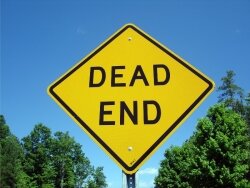Culs sacked: But has the dead end died?
Another piece of the American dream took a hit when Governor Tim Kaine signed a regulation last month that ends state maintenance of roads in subdivisions that aren't connected. While some decry the Norman Rockwell-esque loss of children riding bikes and playing stick ball on deserted culs-de-sac, for many others, that nostalgic ideal was no longer any more workable than the V-8 station wagons and other land sharks in fashion at the dawn of suburbia.
"We are not outlawing cul-de-sacs," emphasizes Gordon Hickey, spokesman for Kaine. "You can build all the cul-de-sacs you want. We just don't want to maintain them."
The state regulation came after 18 months of public hearings and workshops before the Commonwealth Transportation Board, says Hickey.
"It's a congestion issue, it's a land use issue, and money is always involved," he says. Income for the state, such as the gas tax, is going down, limiting its ability to fund or even maintain roads.
"It's also common sense," says Hickey. "This is not a development strategy that works over the long term."
In many ways, Albemarle is ahead of the connectivity curve– at least on paper. Realizing the crunch of traffic funneling out from one-entrance neighborhoods off U.S. 29 north or Route 240 in Crozet, the county changed its subdivision ordinance in 2005 to comply with the so-called Neighborhood Model it now favors in its comprehensive plan.
"Connectivity allows local traffic to circulate," explains Albemarle planning director Wayne Cilimberg. "You don't have to put it all on the main local roads."
So what happened to the urban street grid pattern? Sometimes topography got in the way, says Cilimberg. But more and more, subdivisions were built to be isolated, depending on cars and roads to get to the separate shopping centers and business parks. Part of that was backed by zoning, which separated residential, commercial and industrial.
"The design of the subdivision is what developers felt residents wanted," says Cilimberg. "There was plenty of land, and roads could be built inexpensively."
Flash forward to the 21st century with the heavier traffic, congestion, and pollution making the walkability of the neighborhood model more appealing.
"I live on a cul-de-sac," says Forest Lakes neighborhood board member Carmine Covais. "We love it. It's a concept very good in terms of livability. It's quieter and safer."
Covais understands the congestion conundrum from cul-de-sac life, and he favors parallel roads. And he realizes that in the future, people may have to pay more for road maintenance for the privilege of cul-de-sac living.
"When I was a kid, it was the dead end street, as cul-de-sacs were called, that was the only place we were allowed to ride bikes and play with other kids," remembers Erin Keiningham, who now is a parent and lives in a one-entrance subdivision herself, although not on a cul-de-sac.
There have been very few complaints from developers, according to Bill Fritz, Albemarle's development chief. "I'm scratching my head and coming up dry," he says.
Fritz also dispels the myth that culs-de-sac are gone. New regulations don't take them away– there just may be fewer of them.
#
